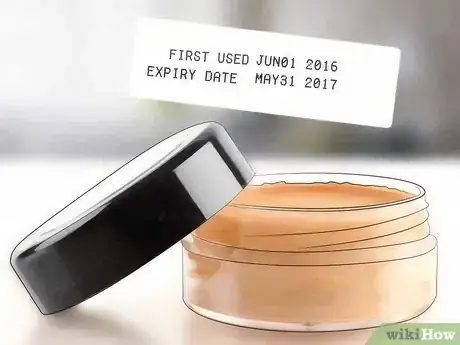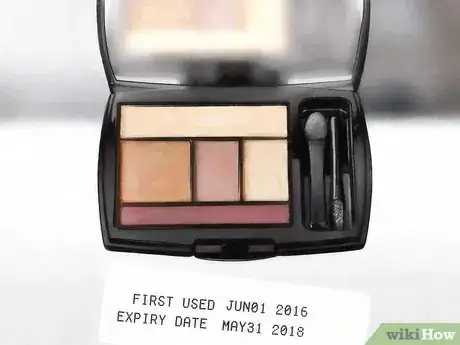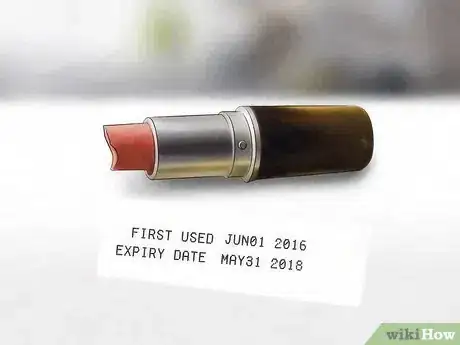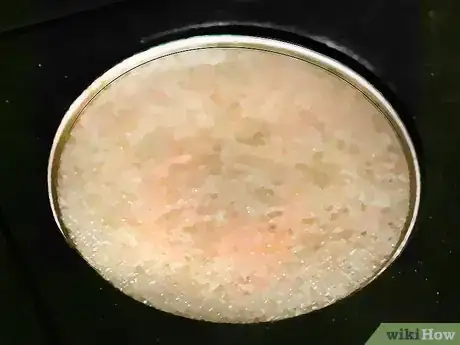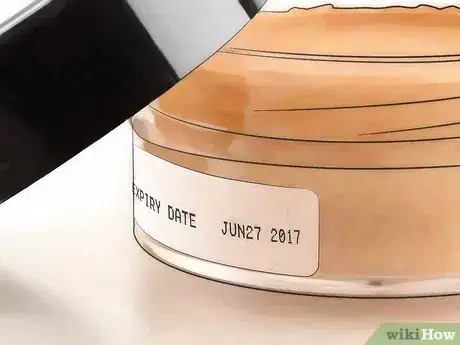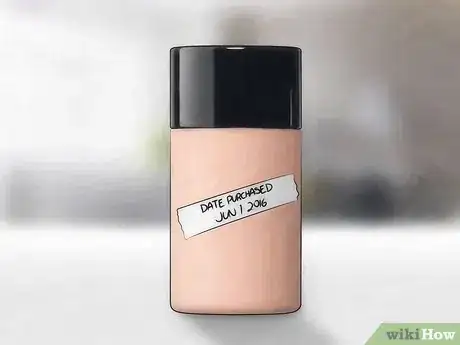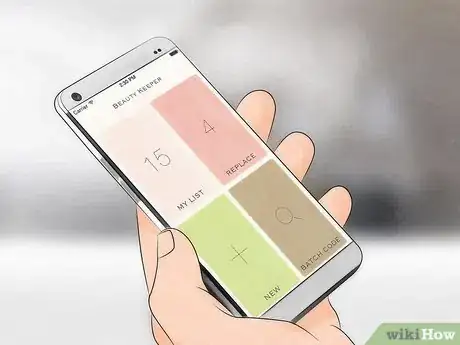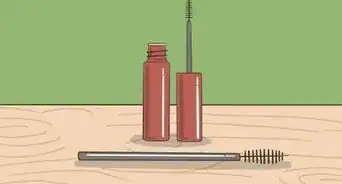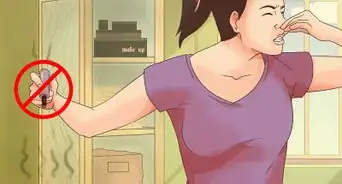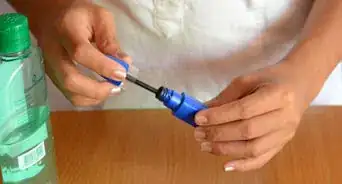This article was co-authored by Katya Gudaeva. Katya Gudaeva is a Professional Makeup Artist and the Founder of Bridal Beauty Agency based in Seattle, Washington. She has worked in the beauty industry for over 10 years and worked with companies such as Patagonia, Tommy Bahama, and Barneys New York and with clients such as Amy Schumer, Macklemore, and Train.
This article has been viewed 81,088 times.
If you spend a lot on makeup, it's only natural to want to get your money's worth. But that doesn't mean you should hold onto your foundation and lipstick indefinitely. Old makeup can harbor bacteria, cause infections, and damage your skin, so it's important to know when to throw it away. If you're not sure how to tell when it's time, there are a few guidelines and signs that can help.
Steps
Knowing Your Expiration Guidelines
-
1Throw away foundation and concealer after a year. Most liquid and cream foundations are water-based, which means that they’re a prime breeding ground for bacteria. Concealers have similar formulas, so they can turn just as quickly. Using old, contaminated foundation and concealer can lead to breakouts, as well as more serious skin irritations.
- Old foundation and concealer usually don’t perform as well either. You can wind up a streaky finish and poor coverage if your products are too old.
Expert AnswerQWhen asked, "How do you know when your makeup is expired?"
Katya Gudaeva is a Professional Makeup Artist and the Founder of Bridal Beauty Agency based in Seattle, Washington. She has worked in the beauty industry for over 10 years and worked with companies such as Patagonia, Tommy Bahama, and Barneys New York and with clients such as Amy Schumer, Macklemore, and Train.Professional Makeup Artist
 EXPERT ADVICEAnswer from Katya Gudaeva:
EXPERT ADVICEAnswer from Katya Gudaeva:Professional makeup artist Katya Gudaeva responded: "Dry products like eyeshadows and powders are usually fine for years because bacteria doesn't really thrive in a dry environment. However, you should throw out creams after about a year, especially creams you apply with your fingers or brush directly from the package, like cream blush or highlighter."
-
2Get rid of face powder, eye shadow, and blush after two years. Powder products tend to have a longer shelf life than liquids and creams because they don’t provide a moist environment for bacteria and germs to grow. However, over time the small amount of water that’s in powder products evaporates, leaving them crumbly and difficult to use. [1]
- If you powder products are old, you may notice that they’ve become more firmly packed in their pans, so it’s harder to pick up any color when you dip your brush into them.
- Because they contain water, cream eye shadows and blushes should be tossed after 6 months to a year.
Advertisement -
3Toss lipstick and lipgloss after one to two years. They’re usually oil-based, which means that they also provide a good environment for bacteria to grow. Add in the fact that you’re constantly applying them to your mouth, and you definitely don’t want to hang onto your favorite lip products too long.[2]
- When you use a lipstick that’s past its prime, you may notice that it doesn’t glide on as easily as it used to. That’s because it has a tendency to dry out over time.
- When it comes to lip liners, you usually have up to two years before you have to throw them away. They typically have drier formulas than lipstick or glosses, so they aren’t as likely to breed bacteria.
EXPERT TIPKatya Gudaeva is a Professional Makeup Artist and the Founder of Bridal Beauty Agency based in Seattle, Washington. She has worked in the beauty industry for over 10 years and worked with companies such as Patagonia, Tommy Bahama, and Barneys New York and with clients such as Amy Schumer, Macklemore, and Train.Professional Makeup Artist
 Katya Gudaeva
Katya Gudaeva
Professional Makeup ArtistPay attention to your lipstick's smell. Makeup artist Katya Gudaeva continues: "When lipstick expires, you'll notice a very specific smell, like your grandma's lipstick. If it doesn't smell bad, it's probably safe, but if it does, it's time to throw it away."
-
4Purge eyeliner and brow pencils after a year. These products usually feature a large amount of waxes, which aren't as conducive to growing bacteria as other ingredients. However, because both are used around the eyes, you should be careful and get rid of them after 12 months to prevent irritation.[3]
- If your pencils are the type that you sharpen, you can hang onto them for up to two years. That’s because every time you sharpen them, you get rid of the top layer of the pencil where bacteria is most likely to present. Just make sure to sharpen before each use, and clean your sharpener with alcohol regularly.
-
5Switch up liquid eyeliner, cream eyeliner, and mascara after three months. Of all the makeup products that you own, mascara and liquid liner are probably the most likely to grow bacteria. That’s because the inside of their tubes provide a dark, wet environment that’s perfect for bacteria. Cream liners are always a problem because they usually come in jars that you have to dip your brush into, so they’re easy to contaminate.[4]
- Mascara, liquid liners, and cream liners become noticeably dry when they’re more than a few months old.
- Using old mascara, liquid liner, or cream liner can lead to a variety of eye irritations, such as redness and itchiness. In more serious cases, it may cause styes and even conjunctivitis, more commonly known as pink eye.
Looking for Signs
-
1Pay attention to changes in smell. When makeup products such as foundation, lipstick, and mascara go bad, you may notice that that they start to smell bad. Mascara can start to take on a gasoline-like scent, while lipstick may begin to smell like stale cooking oil. Take note of what your products smell like when you first purchase them, so you’ll be able to tell if the scent changes.
-
2Check for changes in consistency. The ingredients in liquid makeup products, such as foundation, may begin to separate over time. You’ll notice that the oils rise to the top of the bottle, while the pigments remain at the bottom. Products may also become thicker as they start to go bad.[5]
- Moist products, such as mascara, often become drier and almost powdery when they start to turn.
- Pressed powder products, including eyeshadow, face powder, and blush, may develop a film across their surface. It’s usually the result of contact with residue from the oils in your skin and other face products, such as moisturizer and sunscreen.
-
3Look for changes in color. It’s not uncommon for makeup items to exhibit changes in color as they get older. Your foundation and concealer may start to look a little darker, while blushes and eyeshadows may no longer appear as vibrant. If your makeup shows any changes in color, it’s time to throw it away.[6]
-
4Consider where you store it. Certain environmental factors, such as heat and humidity, can make your makeup go bad more quickly because they encourage the growth of yeast and mold. That’s why the bathroom isn’t the best place to keep your products. Exposure to direct sunlight and extreme cold can also make makeup spoil faster.[7]
- A cool, dry location, such as a linen closet or bedroom drawer, is an ideal place to store makeup if you want it to last as long as possible.
Keeping Track of Your Makeup
-
1Notice the expiration date. These days, many makeup items tell you upfront how long they’re good for. They’re usually marked with a MM/YY date that tells you when you should throw it away. If an item doesn’t have a specific date, it may have a PAO (period after opening) mark that tells you how long the product is good for once you open it.[8]
- The PAO mark appears as number inside a small jar symbol. 6M, for example, would mean that a product is good for six months after the date that you open it.
- Expiration dates and PAO marks are only guidelines. If you notice changes in color, consistency or scent prior to the dates on the packaging, you should still throw away the products.
-
2Label items with date of purchase. Some products may not have an expiration date or PAO mark, so it’s up to you to use the standard guidelines to know when to throw them out. It can be difficult to remember when you bought a certain tube of lipstick or blush, though, so it’s a good idea to put a label on the item with the date. That way, you’ll know precisely when you should throw it away.
- Instead of labeling the makeup with the date that you bought it, figure out the date that you should get rid of it according to the general guidelines and write that on the table that you place on it.
-
3Use apps to help keep track. If you have items in your makeup drawer that don’t have expiration dates or POA marks, and you haven’t labeled them, all hope isn’t lost. There are several apps, such as Beauty Keeper, Check Fresh, and Check Cosmetic, that helps you figure out when an item was manufactured. All you have to do is input the item’s batch code, which is a number usually printed somewhere on the product.[9]
Community Q&A
-
QuestionHow do I know if my mascara bottle is empty?
 Community AnswerYou can try shaking it or turning it upside down to check. There is usually an expiration date on makeup.
Community AnswerYou can try shaking it or turning it upside down to check. There is usually an expiration date on makeup. -
QuestionHow can you tell if liquid lipstick tube is empty?
 Community AnswerThe best way to tell if the tube is empty to rest it on a flat surface, standing upright, and allow it to sit for a day or so. That will allow all of the remaining product to fall from the sides of the tube to the bottom, where the applicator is. When you pull it out, examine it to see how much lipstick is on the brush or applicator -- if there's hardly any product on it, the tube is likely empty or close to it.
Community AnswerThe best way to tell if the tube is empty to rest it on a flat surface, standing upright, and allow it to sit for a day or so. That will allow all of the remaining product to fall from the sides of the tube to the bottom, where the applicator is. When you pull it out, examine it to see how much lipstick is on the brush or applicator -- if there's hardly any product on it, the tube is likely empty or close to it. -
QuestionCan you put lipstick in the microwave to kill germs, then in a jar to reuse?
 Community AnswerNo, you should never microwave your cosmetics. It will not only kill germs, but also break down the chemistry and consistency of the makeup.
Community AnswerNo, you should never microwave your cosmetics. It will not only kill germs, but also break down the chemistry and consistency of the makeup.
Warnings
- If you experience any irritation from a makeup item, throw it out immediately. See a doctor if the symptoms don’t improve in a day or two.⧼thumbs_response⧽
References
- ↑ http://www.goodhousekeeping.com/beauty/makeup/tips/a17714/expired-beauty-products/
- ↑ http://www.allure.com/beauty-products/2010/how_to_know_when_your_beauty_products_expire#slide=8
- ↑ http://www.goodhousekeeping.com/beauty/makeup/tips/a17714/expired-beauty-products/
- ↑ http://www.goodhousekeeping.com/beauty/makeup/tips/a17714/expired-beauty-products/
- ↑ http://www.goodhousekeeping.com/beauty/makeup/tips/a17714/expired-beauty-products/
- ↑ http://www.allure.com/beauty-products/2010/how_to_know_when_your_beauty_products_expire#slide=6
- ↑ http://www.goodhousekeeping.com/beauty/makeup/tips/a17714/expired-beauty-products/
- ↑ http://www.today.com/style/it-time-throw-out-your-makeup-5-ways-know-when-t65776
- ↑ http://www.today.com/style/it-time-throw-out-your-makeup-5-ways-know-when-t65776
